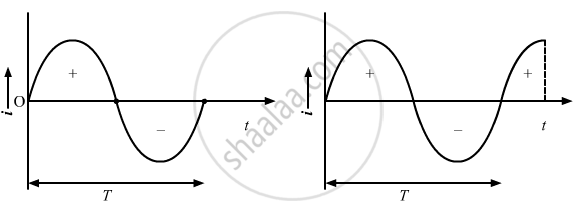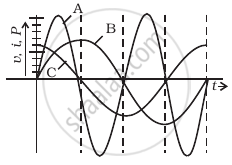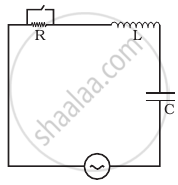Advertisements
Advertisements
प्रश्न
An AC source is rated 220 V, 50 Hz. The average voltage is calculated in a time interval of 0.01 s. It
पर्याय
must be zero
may be zero
is never zero
`is (220//sqrt2 )V`
उत्तर
may be zero
Let the AC voltage be given by,
`V = V_0sin omegat`
Here, ω = `2pi` f = 314 rad/s
The average voltage over the given time,
Here, ω = `2pi` f = 314 rad/s
The average voltage over the given time,
Vavg = \[\frac{\int_0^{0.01}Vdt}{\int_0^{0.01}dt}\]=` -V_0 [(cos omega)/omega]_0^0.01`
= `V_0/(wxx0.01) (1 - cospi)`
= `(2V_0)/pi=140.127V`
Also, when V = V_0 cos `omegat`
Vavg =\[\frac{\int_0^{0.01}Vdt}{\int_0^{0.01}dt}\]=` -V_0 [(cos omega)/omega]_0^0.01`
=` V_0 /(omegaxx0.01) (sin omega(0.01)-0)`
=`V_0/(314xx0.01)(sin omega (0.01)-0)`
= `V_0/3.14 (sinpi)`
=0
From the above results, we can say that the average voltage can be zero. But it is not necessary that it should be zero or never zero.
APPEARS IN
संबंधित प्रश्न
A 2 µF capacitor, 100 Ω resistor and 8 H inductor are connected in series with an AC source.
(i) What should be the frequency of the source such that current drawn in the circuit is maximum? What is this frequency called?
(ii) If the peak value of e.m.f. of the source is 200 V, find the maximum current.
(iii) Draw a graph showing variation of amplitude of circuit current with changing frequency of applied voltage in a series LRC circuit for two different values of resistance R1 and R2 (R1 > R2).
(iv) Define the term 'Sharpness of Resonance'. Under what condition, does a circuit become more selective?
A current i1 = i0 sin ωt passes through a resistor of resistance R. How much thermal energy is produced in one time period? A current i2 = −i0 sin ωt passes through the resistor. How much thermal energy is produced in one time period? If i1 and i2 both pass through the resistor simultaneously, how much thermal energy is produced? Is the principle of superposition obeyed in this case?
An AC source producing emf ε = ε0 [cos (100 π s−1)t + cos (500 π s−1)t] is connected in series with a capacitor and a resistor. The steady-state current in the circuit is found to be i = i1 cos [(100 π s−1)t + φ1) + i2 cos [(500π s−1)t + ϕ2]. So,
The peak voltage of a 220 V AC source is
The AC voltage across a resistance can be measured using
A bulb rated 60 W at 220 V is connected across a household supply of alternating voltage of 220 V. Calculate the maximum instantaneous current through the filament.
The dielectric strength of air is 3.0 × 106 V/m. A parallel-plate air-capacitor has area 20 cm2 and plate separation 0.10 mm. Find the maximum rms voltage of an AC source that can be safely connected to this capacitor.
A transformer has 50 turns in the primary and 100 in the secondary. If the primary is connected to a 220 V DC supply, what will be the voltage across the secondary?
Compare resistance and reactance.
A device Y is connected across an AC source of emf e = e0 sin ωt. The current through Y is given as i = i0 sin (ωt + π/2).
- Identify the device Y and write the expression for its reactance.
- Draw graphs showing a variation of emf and current with time over one cycle of AC for Y.
- How does the reactance of the device Y vary with the frequency of the AC? Show graphically.
- Draw the phasor diagram for device Y.
Average power supplied to a capacitor over one complete cycle is ______.
A capacitor has capacitance C and reactance X, if capacitance and frequency become double, then reactance will be ______.
A device ‘X’ is connected to an a.c source. The variation of voltage, current and power in one complete cycle is shown in figure.
- Which curve shows power consumption over a full cycle?
- What is the average power consumption over a cycle?
- Identify the device ‘X’.

Explain why the reactance provided by a capacitor to an alternating current decreases with increasing frequency.
In the LCR circuit shown in figure, the ac driving voltage is v = vm sin ωt.
- Write down the equation of motion for q (t).
- At t = t0, the voltage source stops and R is short circuited. Now write down how much energy is stored in each of L and C.
- Describe subsequent motion of charges.

